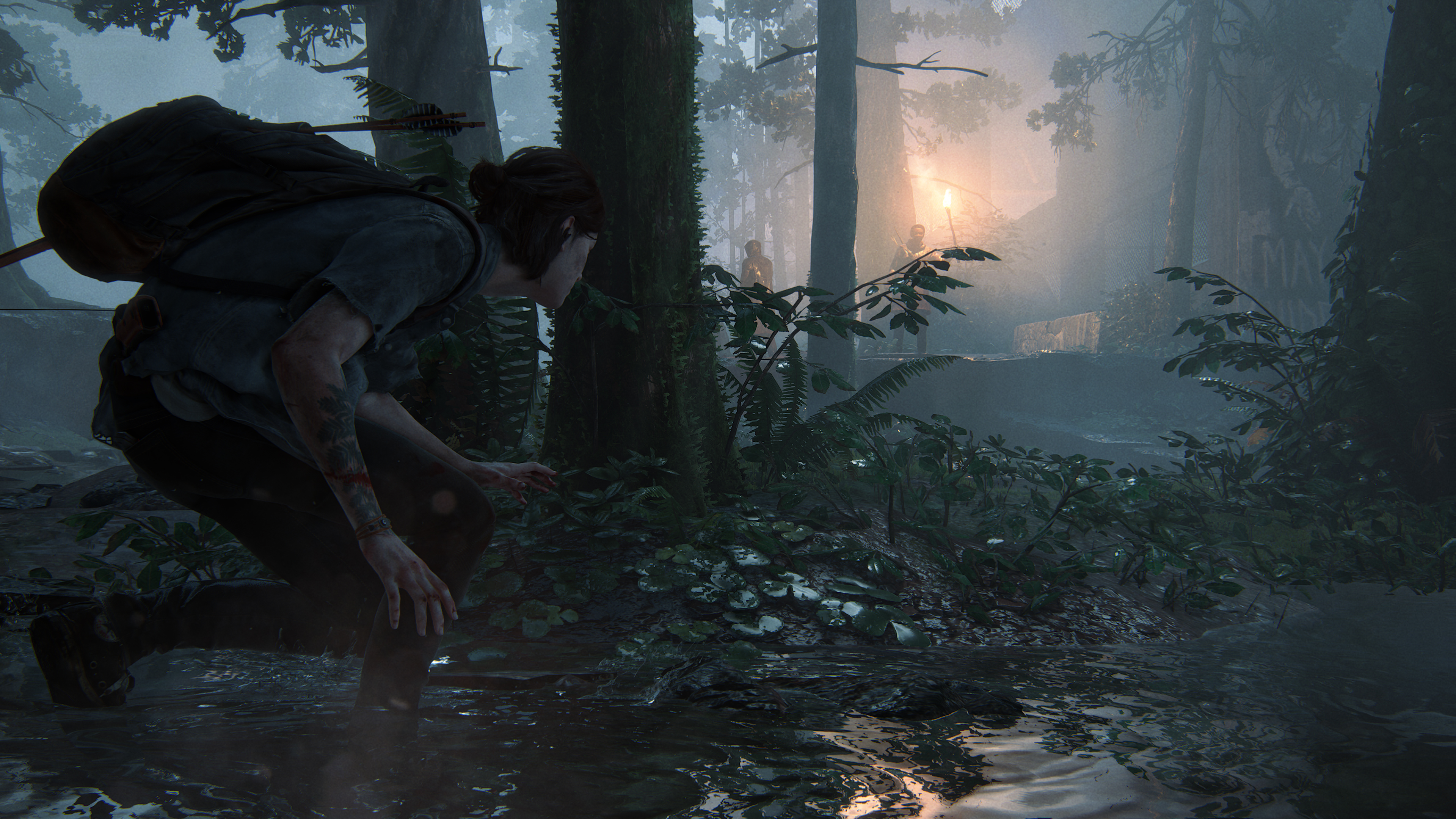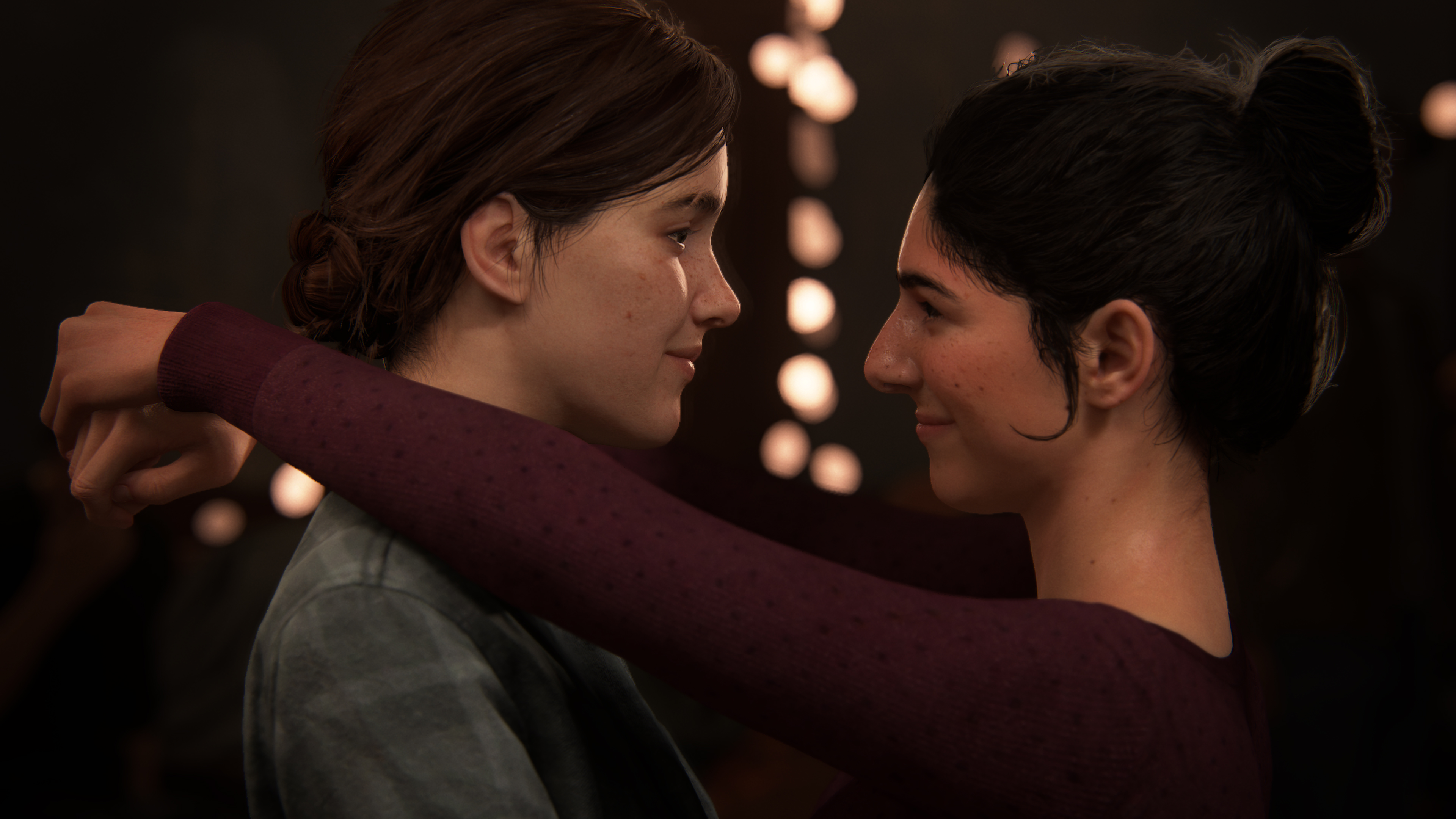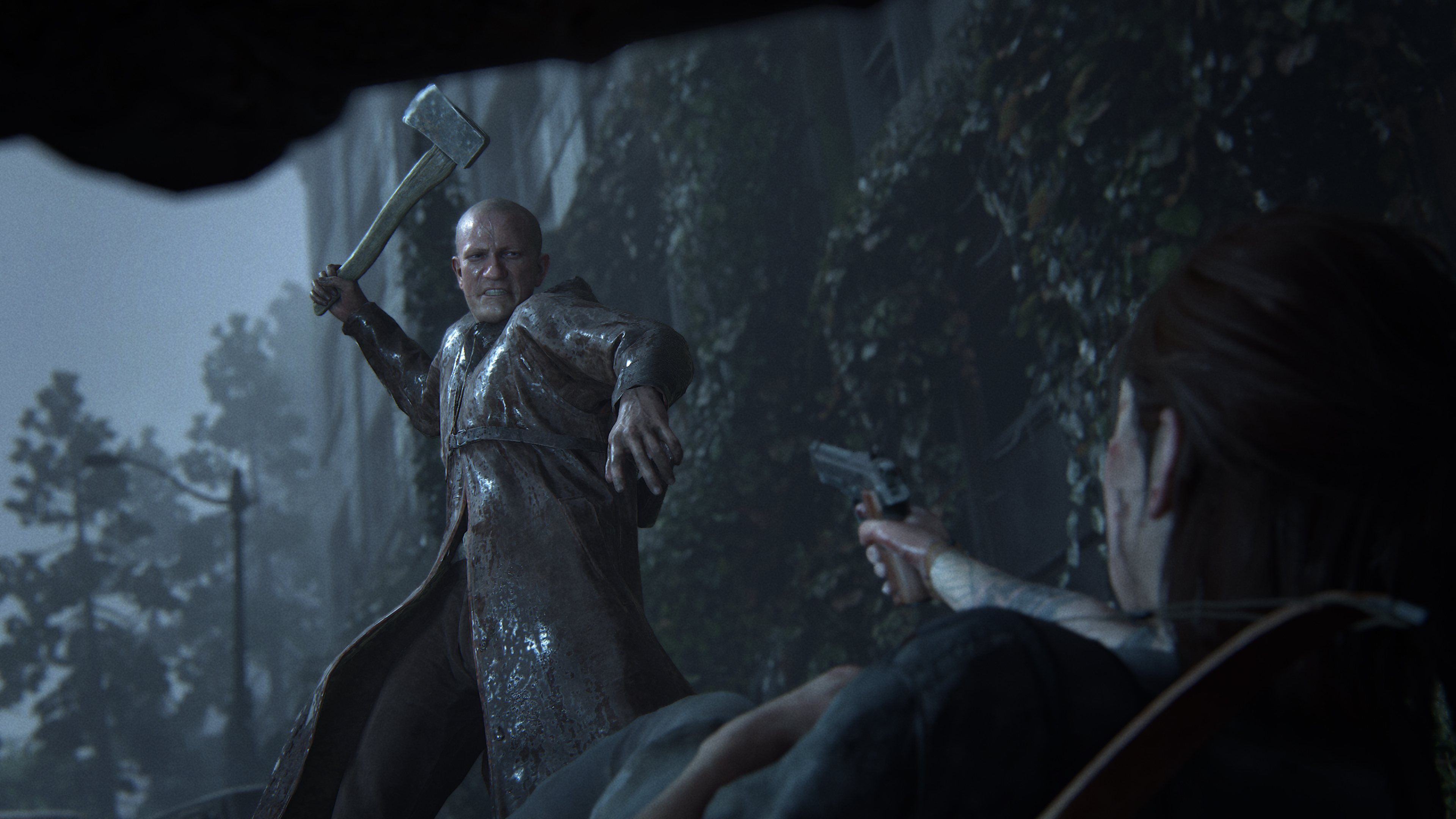'The Last of Us' Developers Discuss Realistic Kissing, Queer Fridging, More
Danielle Riendeau
Jun 22 2018, 12:01am
We spoke with 'The Last of Us Part II' creative director Neil Druckmann and co-writer Halley Gross on THAT KISS and the demo's implications about violence.
During E3 2018, on Sony’s big stage, I saw something I never thought I’d see in a massive blockbuster game: something that looked like realistic, happy queer romance.
We talked about it a bit during our
E3 podcast, but the demo for
The Last of Us Part II starts off with a scene where Ellie—the protagonist of the new game, after her turn in the first—shares a sweet, sexy, realistically bumbling dance and kiss with Dina, another major character in the story.
In the scene, we cut from a cinematic featuring the best kiss I’ve ever seen in a game to a gameplay segment that is everything the cutscene is not: a grimy, brutal sequence with plenty of intense stealth and nasty killings, as Ellie makes her way through a stage of bad guys who all want her dead.
Then, as the demo ends, it cuts in on the end of the kiss, with a blushing, smiling couple, and a smash cut to the game’s logo.
I had the opportunity to speak with the game’s creative director, Neil Druckmann, and co-writer Halley Gross, on creating that scene—including all the new tech that went into making that kiss play so well—and their decision to place a romantic scene and a brutally violent one so close together in the demo.
Naughty Dog has had a very busy couple of years, with the release of
Uncharted 4,
Uncharted: The Lost Legacy, and now, the sequel to one of the most highly regarded Playstation games when
The Last of Us Part II lands.
I'd like to note, as with all things we write about the studio, we don't condone the company's
mishandling of sexual misconduct allegations. Briefly, an employee claimed that he was routinely sexually harassed by a lead at Naughty Dog, and was fired for speaking up to HR about his harassment. Sony and Naughty Dog followed up with a statement that left a great deal to be desired, as Patrick wrote last October when the story broke: "Naughty Dog's response hardly seemed like an lengthy investigation into the accusations, which would have taken more than a weekend to properly vet. Whether a full investigation will take place is unclear." So far as we know, no such investigation has taken place.
I didn't speak to the team about those allegations in this sitting.
This interview has been lightly edited for clarity and length.
Waypoint: How was the response from the trailer?
Neil Druckmann, creative director: I didn’t get to dive in too deep, and I’m trying not to dive too deep [Gross laughs], but it seems to be positive, it seems to be a really good reaction. There’s some weird homophobic stuff that I don’t care for.
Halley Gross, co-writer: It’s exciting to have it out there!
So, I’m outwardly queer, I got excited about the trailer, tweeted about it, etc. It’s a really big deal, to be at E3, to have queer women kissing be the first thing Sony shows at its big press event, and this feels like planting a flag in a way. What went into that decision to really make this part of her character and the decision to make this part of the demo itself?
Druckmann: When E3 comes up, we try to figure out which slice of the game—what would be an interesting thing for people to come away with? We’re trying, in a very short amount of time, to convey all these different things. The aesthetics of the game, how it plays, the emotional tone that we’re after.
As far as owning who Ellie is, that was a no brainer. In
Left Behind, we established that she’s gay. And it felt like, if she’s going to be 19, and lives in a somewhat safe community, of course she would pursue romance. So, we’ve always wanted to explore that. And then, juxtaposing those two elements of seeing Ellie—awkward and hopeful and shy and happy! The happiest we’ve ever seen her.
Contrasted against her being desperate, a survivalist, maybe even a little sadistic in what she’s committing, and say, ‘that’s the same character.’ So that felt like a nice kind of juxtaposition, with the themes of The Last of Us, contrasting beauty with darkness in the world and how that trickles down through people.
And then once we’ve made that decision, and we had our transition how we go from the cinematic to gameplay, also we realized ‘oh, we’re going to show this kiss in a Sony press conference!’ It might be a big deal!
[Both laugh]
And then we just like, it was like this rallying thing! Like, ‘yeah, lets fucking own it! Let’s make this the best kiss ever in any video game!’ and lets put all the resources into that, because it is so important to the story.
Once we realized certain things, like ‘this is really important to the story,’ whether its this really tender moment, or an uncomfortable violent moment, we lean into that and we put the appropriate resources into it.
Can you talk a bit about those resources, because, it was the best kiss I've seen in a game.
[Both laugh]
Oh! I could try! [laughs] I’m sure I’ll miss certain technical things!
There’s things called soft mods which [affects] the way skin can move especially when colliding with another person’s skin so you don’t just get things inter-penetrating. There’s extra joints in the nose for when Ellie puts her face against Dina’s and pushes to the side. There’s new tech so that when Ellie pulls back she blushes, so her face actually, in real time, turns red.
Because we’re closer, we have new shaders for the teeth, the teeth get shadows appropriately for the lips.
Because if any one of those things go wrong, you’re pulled out of the experience. So all these things have to come together and even the sound of kissing—we had like—[Gross laughs]
What we had recorded on the stage wasn’t quite right, so we actually had a whole foley session of recording kissing sounds.
Ellie’s lips are wet, so there was a pass that was done after. So when they seperate there’s a little bit of like wetness on the lips. It’s all these subtle things you might not even pick up, but any one of them missing, you’re like ‘something was off…I can’t tell you what exactly but something was off about it.’
The hair! So that had to go through physics, to joints that had to be hand-animated, and going from hand to hair!
Did it take like, weeks?
Months!
Gross: [Laughing] Weeks, ha!
Druckmann: And even the rest of that scene, there were all the people dancing, that was an epic mo-cap session. Because we actually needed more people than we could capture at any one time. So we had to bring in a dance choreographer, a dance group, and like, do it in chunks. And when I talked to the lead cinematic animator, I was like ‘is this one of the hardest scenes you’ve ever done?’ And he was like ‘one of? This is
easily the hardest scene we’ve ever done!’
So one thing I think a lot of folks were concerned about is the idea of fridging. That Dina would be killed to give Ellie dramatic motivation. I’m not asking you to spoil the story, but are you aware of the tropes, given the history of queer women in film and TV, etc.? Are you aware of that while writing these characters and scenarios, and secondarily, I imagine there’s a lot of pressure on you folks to ‘get it right.’
Gross: That’s an almost impossible one to answer!
Druckmann: [To Gross] I can ramble for a bit and you can take over! [To me] I’ll try without spoiling anything! I will say that knowing we’re in a genre that has certain tropes—and genre might just be relationship story, or zombie apocalypse, we’re constantly considering tropes.
Sometimes we lean into tropes where they’re best for the story and sometimes we want to subvert them in interesting ways. So I can tell you, especially with that stuff, there’s a lot of conversations about—not only that trope [regarding fridging] but other tropes that come from that kind of relationship.
And ultimately what wins out is what’s best for the story.
So, for example, if we’re going to have a lead female gay protagonist in the zombie apocalyptic genre, that means the protagonist will be in really violent situations, both that she’s perpetrating and that’s done to her. And sometimes there are certain tropes that might have negative connotations, but we just have to own it if that’s part of the genre. Again, without spoiling who lives, who survives, because so much of the story is about the stakes of the people you care for.
We’re aware of it, but we’re making the best decisions for the story.
Gross: That was great, I feel like he nailed it! [laughs]
There was a pretty intense juxtaposition of romance and violence that was the hallmark of this demo. What went into that decision?
In terms of showing both?
Yeah, in terms of showing both next to each other, that closely.
One of the goals for this game is to show a very complex, complicated character. By putting those two things next to each other, you’re really seeing Ellie at her most confident and at her most insecure. Ellie at her most capable, and absolutely her most confused and floundering.
So, it was really about trying to earn the confidence and faith of the audience that we are focused on story, we are focused on character, we are honoring Ellie—not just as a cool protagonist, but as a complicated woman.
Druckmann: I’ll just touch on that a little bit. So much of our inspiration for this story is actually real world events we’ve been studying. Good people, under the right circumstances, can easily tip into violence. Especially in societies where you don’t have the rule of law stopping you from doing it.
Part of our research is looking at videos that you know, you don’t normally see on American news programs. We watch very sanitized versions of events. We don’t on the team, because we feel like if we’re going to tell a story about the cycle of violence, we have to absorb some of that stuff—like, real world stuff that’s happening—as part of our research. And thereby, if we’re going to tell this kind of story, we have to lean into that stuff.
Sometimes art can make you—and
should make you—feel uncomfortable. And that’s part of Ellie’s journey. Right? We’re not making the kind of game where you can imbue your moral stance and decide the moral compass of the character. We’re telling a story with a strong character who makes very specific choices, sometimes there’ll be a difference in where you morally stand, and you have to wrestle with that. That is part of the experience of playing this game.
My last question would be if there’s any major piece of feedback from the first game or the DLC that you’ve taken to heart in making Part II.
The big one I would say is AI. We wanted—we had certain ambitions with the first game—that we felt we didn’t quite hit with the AI that this was an opportunity to not only to live up to that promise but surpass it. Some of the levels are much wider and more complex, Ellie has a jump button now so there’s more verticality, and she crawls and can move around that space. Enemies have a much greater awareness of the environment than before, they can communicate with one another, they can dynamically pair up.
Even when you’re in ‘stealth grass,’—in previous titles,
Uncharted 4, specifically—you were either completely hidden, or completely seen. Here, there’s an analogue nature to it, so there’s actually a HUD that shows how hidden you are, which allows enemies to have better perception of how they spot you.
So, all of those things work to make enemies smarter, more threatening and more human.






















